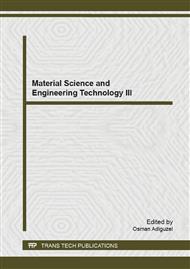p.177
p.181
p.187
p.192
p.198
p.203
p.208
p.212
p.217
Quaternary Ammonium Modified Silica for Gold(III) Sorption
Abstract:
In this research, effect of pH toward adsorption of gold (III) on silica modified with methyl quaternary ammonium (SMQA) has been investigated.Additionally, its application an effect of Cr2O42-on adsorbed [AuCl4]-and effect of pH were carried out and to determine by atomic adsorption spectrometry (AAS). The experimental condition was optimized in batch process to achieve the maximum efficiency. The result showed that optimum pH 5 for adsorption. The gold desorbed increasing before 30 minutes, there were before and after adsorbed gold due at the long distribution axis from transmission electron microscopy (TEM) image. The maximum capacity of SMQA obtained 169.98 mg/g.The R2 values indicate that the Langmuir isotherm fit the the experimental data better than the Freundlich at room temperature. The adsorption gold (III) ion with material SMQA was chemisorption and an effect of Cr2O42-to minimize sorption.
Info:
Periodical:
Pages:
198-202
Citation:
Online since:
April 2015
Keywords:
Price:
Сopyright:
© 2015 Trans Tech Publications Ltd. All Rights Reserved
Share:
Citation:


